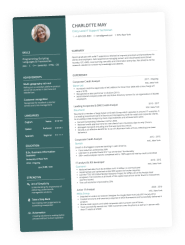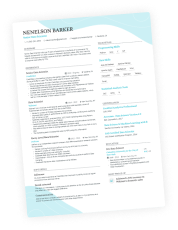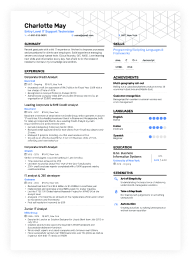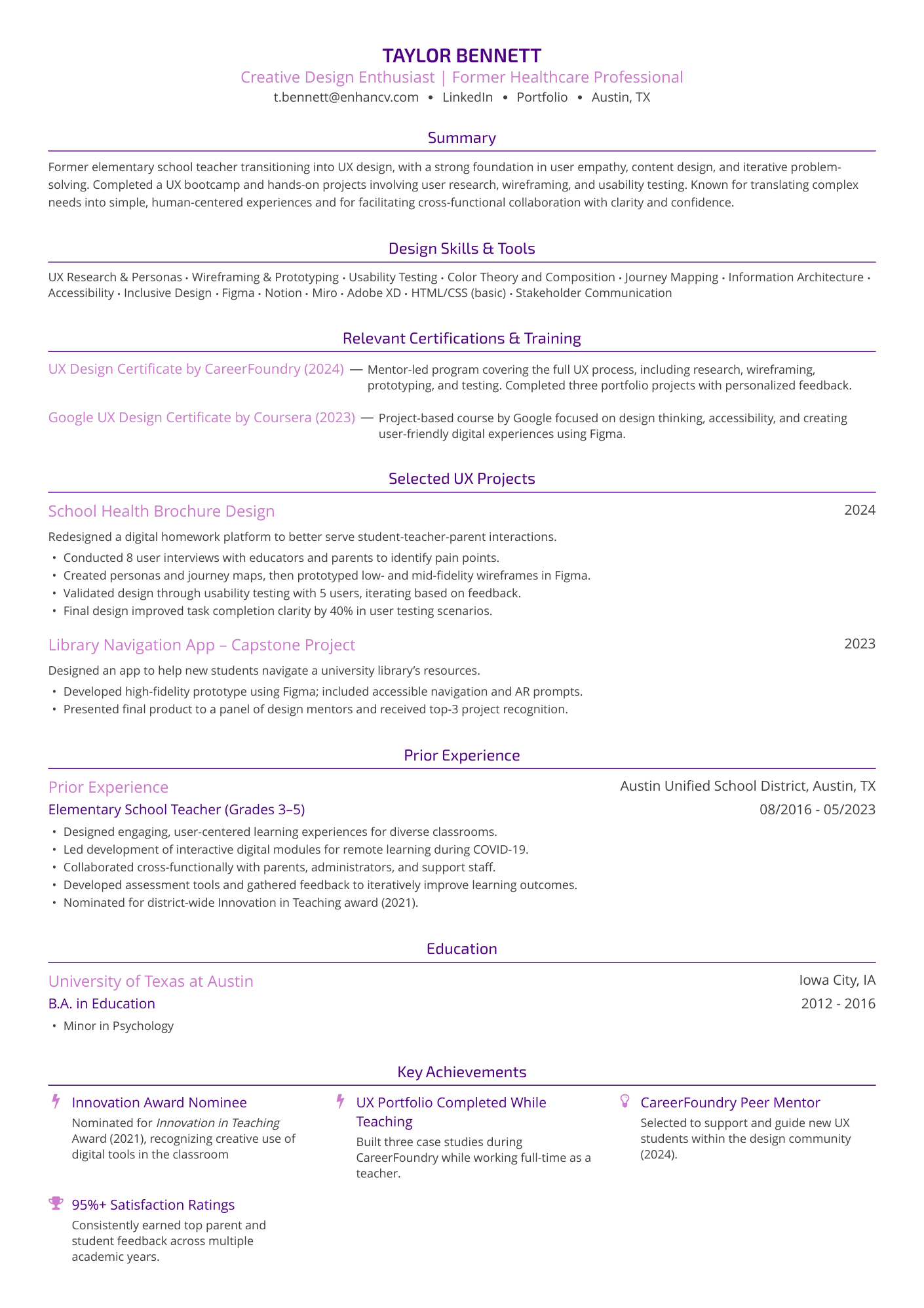It feels like everyone is giving career advice these days—from self-proclaimed career coaches and LinkedIn experts, to anyone who’s ever looked for a job.
The reality is, a big portion of this advice contains outdated, recycled tips. Career blog articles often chase clicks without offering real insight, personal anecdotes rarely apply universally, and AI-generated overviews can’t always be trusted.
Debunking common resume myths is essential for both passing ATS filters and resonating with hiring managers. But how to weed out the incorrect information?
In our article, we address the myths that sound believable—but could cost you interviews. No obvious tips here—just the most persistent myths that job seekers still fall for, and the truth behind them.
Key takeaways
- A good resume doesn’t follow rigid rules—it follows principles like relevance, clarity, and impact.
- You don’t need to stick to one page if your experience deserves more space—just keep it well-structured.
- Modern designs won’t get you rejected by ATS (applicant tracking systems)—as long as your content is text-based and logically formatted.
- Soft skills still matter—just don’t list them, show them through real examples and results.
- Career gaps aren’t deal-breakers if framed honestly and paired with evidence of continued growth.
- Tailoring your resume to each role, avoiding generic fluff, and using active, clear language can make all the difference.
Myth #1: A resume should always be one page
This belief comes from an earlier time—when resumes were printed, faxed, and expected to be ultra-brief. But today, especially with remote and nonlinear careers, cramming everything into one page can hurt more than help.
Here’s the truth: A one-page resume is great if it works but it’s not a hard rule. If you need two pages to tell your story clearly and relevantly, go for it. Clarity beats compression.
Resume fix
Use two pages if your experience justifies it—especially if you’ve been working for 10+ years, have diverse roles, or are in a project-heavy field.
If you choose to go beyond one page, make sure:
- Each section adds value and is relevant to the role
- You avoid repetition, fluff, or unnecessary detail
- The layout is clean, structured, and easy to scan quickly
Take it from remote workers
Did you know that only 35% of remote workers stick to one-page resumes? Turns out, flexible work leads to more expansive career narratives.
As a hiring manager, I’d rather see a two-page resume with a clear story than a one-pager crammed with buzzwords.
Author’s take
Myth #2: Your resume should only cover the last 10 years
Тhis rule works if your older experience is unrelated or you’ve stayed in the same field. But for career changers, executives, or people with notable achievements earlier in their careers, intentionally trimming your history may hide exactly what sets you apart.
Here’s the truth: Cutting off your resume at 10 years isn’t always smart. If your most relevant achievements or leadership roles happened earlier, they deserve a place—as long as you frame them with intent.
Resume fix
That’s where thehybrid resume approach comes in. It allows you to frame your experience selectively. You get the best of both worlds—by putting an equal focus on your skills and your most valuable experiences. Using the combination approach lets you:
- Emphasize experience beyond 10 years without overloading your timeline
- Downplay unrelated roles while preserving narrative flow
- Give recruiters the right context without losing focus
Think of it as selective storytelling—you’re not rewriting your history, you’re reframing it for where you’re headed.
Myth #3: Fancy designs hurt your chances
Personalized design doesn’t equal poor formatting. Yes, applicant tracking systems can get confused by complex visuals. But that doesn’t mean that designs in general are unreadable, and will result in rejection.
What can go wrong with bad formatting?
Imagine you’ve used a table to outline your roles and time frames.
When an ATS scans it, the content can become misaligned—job titles might disconnect from dates or companies, making your experience look inaccurate.
In some cases, the table may be skipped entirely, especially if heavily formatted, meaning crucial sections like experience or skills aren’t indexed. The result? Your resume could appear incomplete or fail to show up in searches, even if you're fully qualified.
Here’s the truth: ATS doesn’t hate design—it just struggles with how design is implemented. As long as your resume uses real text, logical structure, and avoids layout tricks like images or floating text boxes, a well-designed resume can actually improve readability and impact.
Resume fix
You don’t have to choose between style and function—just make sure your design supports clarity and text-based structure.
Here’s how to make your design both human- and ATS-friendly:
- Avoid embedding key content in graphics or images
- Don’t use layout tricks like tables or text boxes to organize experience
- Use standard fonts, clear headings, and consistent spacing
- Keep important information in plain text (especially skills, dates, and job titles)
All Enhancv templates are built with ATS-readability in mind—even the ones with visuals. Good design isn’t just for creatives—it helps any resume stand out at a glance and hold attention.
Check this one out and create yours in minutes with our AI Resume Builder.
Myth #4: Soft skills don’t belong on a resume
Listing “communication” or “problem solving” in a skills section does little to prove you actually have them. So why waste precious space with soft skills instead of listing your technical abilities like Figma or SQL?
Here’s the truth:
They still matter—a lot. Hiring managers consistently look for signs of collaboration, adaptability, leadership, and empathy—even in highly technical roles.
Resume fix
The key is to show your people skills through context and results. Instead of isolating soft skills in a list, weave them into your experience bullets.
PRO TIP
Another way to give more context to your soft skills is on your cover letter—the document that shows the personality behind the quantifiable achievements. That’s where you can tell a quick story that shows how you lead, collaborate, or solve problems in action.
Drop your resume here or choose a file.
PDF & DOCX only. Max 2MB file size.
Myth #5: ATS automatically rejects your resume
Applicant tracking systems are often treated like soulless bots that gatekeep you from your dream job. Truth is, they don’t reject resumes like robots flipping a switch. And there are no bots automatically “eliminating” applicants.
Here’s the truth: What an ATS actually does is scan and organize resumes (this process is called “parsing”), so recruiters can quickly search, filter, and sort through applicants based on keywords, experience, and job fit.
If your resume doesn’t show up after filtering, it’s usually because of formatting issues or missing relevant language, not because the ATS decided to reject you.
Besides, even after an ATS sorts candidates, real recruiters are still the ones reviewing resumes and making decisions. Ultimately, it’s up to the company—and its hiring team—to review applications responsibly.
Does everybody use ATS these days?
Not really. While large companies and global enterprises almost always rely on some form of applicant tracking system—often to manage hundreds or thousands of applications—only 20% of small and medium-sized companies use ATS.
ATS use is also more common in the US and Western Europe, and far less widespread in smaller markets or early-stage startups.
Resume fix
It’s worth making your resume ATS-friendly—especially if you’re applying to corporate, government, or multinational roles. But it’s just as important to understand why these systems exist in the first place: not to block you, but to help recruiters handle volume and surface the best-fit candidates more efficiently.
Here are some tips on optimizing your resume for ATS
- Use standard fonts (like Rubik, Arial, or Calibri) and clear section headers like Experience, Education, and Skills.
- Include keywords from the job description, especially titles, tools, and certifications—but work them in naturally.
- Save your resume as a PDF to keep your layout intact.
Myth #6: If you have gaps, you should hide them
Career gaps are common—especially post-COVID—and recruiters are increasingly aware that life doesn’t follow a perfect timeline. Trying to hide them can do more harm than good, especially if you alter dates or fabricate filler roles.
Here’s the truth: Taking a break doesn’t mean weakness or lack of dedication to your career. Sometimes, you’ve got to step back and see the bigger picture before you go forward.
Resume fix
Being honest, however, doesn’t exclude being strategic about pauses in your career.
Here are some ways to frame them thoughtfully:
- Label them transparently (“Career Sabbatical,” “Parental Leave”).
- Add bullets for any freelance, volunteer, or upskilling work.
- Emphasize how you stayed engaged or prepared for your return.
- •Completed an online certification in Project Management (Google PM Certificate)
- •Volunteered as communications lead for a local nonprofit initiative, coordinating monthly newsletters and community outreach
- •Maintained professional development through industry podcasts, webinars, and part-time consulting for a former employer
Myth #7: Recruiters only spend 6 seconds on your resume
The idea that recruiters only spend six seconds on your resume comes from a 2012 eye-tracking study by TheLadders. It found that recruiters took about six seconds to perform an initial scan, focusing mostly on names, job titles, companies, and dates.
The study is still widely cited but often misinterpreted as meaning that resumes are only read for six seconds—which was never the point.
And anyway, do we really need to cite a 15-year old study?
Here’s the truth: recruiters still skim quickly at first, especially with high volumes, but if your resume is clear, relevant, and well-structured, they’ll spend much more time reviewing it.
Resume fix
Here’s what to include to win that first glance and earn a deeper read
- A strong header and summary that position you for the role
- Easy-to-spot, results-based achievements
- Clear layout with bold job titles, dates, and impact metrics
- Consistent formatting
- Strategic use of white space
Common mistakes to avoid in a good resume
Busting resume myths is one thing—but even when you know the truth, it’s easy to slip into habits that weaken your resume.
These common mistakes might seem minor, but they can quietly sabotage a strong application.
Typos
Even a single typo can undermine your credibility—especially when attention to detail is part of the job. Recruiters notice. Always proofread carefully and, when in doubt, ask someone else to take a second look.
Using the same resume for every job
Sending the exact same resume to every employer is a fast way to get overlooked. A good resume speaks directly to the role. The more tailored it feels, the more likely it is to resonate with the person reading it.
Listing outdated software or irrelevant experiences
Adding tools or technologies that are no longer in use—or including jobs that have little to do with your current career goals—can dilute your message. Focus on recent, relevant experience that supports the role you’re applying for. If you include older positions, do so strategically, and highlight transferable skills that still apply today.
Including personal information that invites bias (age, marital status, etc.)
Modern US resumes should leave out details like your date of birth, marital status, or nationality. These details aren’t just unnecessary—they can unintentionally expose you to bias. Keep the focus on your qualifications and experience, not your personal background.
Overusing passive language or vague buzzwords
Phrases like “responsible for” or “results-oriented team player” are so overused they’ve lost meaning. Instead of vague buzzwords, use strong, active verbs and concrete results. Show how you contributed, improved, or led—and back it up with metrics when possible. Clear, direct language is far more persuasive than padding.
Frequently asked questions about good resume practices
Wondering about a thing or two more? Check out the questions below.
What is the best resume format?
The most widely recommended format is the reverse-chronological—where your most recent experience comes first. It’s familiar to recruiters, easy to scan, and ATS-friendly.
That said, the hybrid format is great for career changers or those with non-linear paths, and the functional one can work if you’re emphasizing skills over job history.
Should I include a photo on my resume?
Depends on the country you’re applying in. In the US, Canada, and the UK, photos are generally discouraged as they can introduce unnecessary bias.
However, in some countries, like Spain, or visually-driven fields like acting or modeling, it’s customary to do so.
Can I use AI tools to help write or edit my resume?
These days, most candidates do—and when used intentionally, AI tools can be a powerful asset. Models like ChatGPT can help you brainstorm bullet points, rewrite awkward phrasing, or target the specific job description.
For example, you can feed it your current resume and ask for optimized versions based on the job you're applying for, or ask it to identify important keywords from the job ad, or proofread your final version, and so on.
The possibilities are endless, but always review AI’s suggestions to avoid your resume sounding stiff and robotic.
Conclusion: What does a good resume really look like?
We’ve just debunked some of the most persistent myths about resumes—from page limits and design fears to misguided keyword strategies. And what’s left when the noise clears?
A good resume doesn’t follow rigid rules—but it does follow a clear set of principles. It’s not about fitting everything onto one page, or stripping your personality to “beat the bots.” It’s about presenting your experience in a way that’s relevant, readable, and real.
Here are the characteristics of a good resume:
- Tailored to the job—with keywords that reflect the actual role
- Tells a story—not just what you did, but the impact you had
- Easy to scan—with clear formatting, consistent structure, and white space
- Honest and focused—with no filler, vague buzzwords, or outdated tools
- Balances design and function—readable by ATS, but appealing to humans
- Includes both hard and soft skills—and shows, not just tells, where they show up
By rethinking how your resume is built, focusing on relevance, achievements, and readability, you’ll put yourself in a far better position to stand out in today’s competitive market.
Make one that's truly you.





